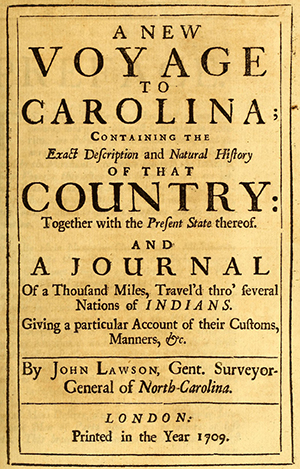A New Voyage to Carolina
by Marcus B. Simpson Jr., 2006
 John Lawson's A New Voyage to Carolina, published for the first time in 1709, is among the most comprehensive accounts of North American Indian culture and natural history written during the American colonial period. A London native, Lawson arrived in Charles Towne (present-day Charleston, S.C.) in August 1700 and soon set off on a 550-mile trek through the wilderness backcountry of the Carolina colony. He settled near the site of present-day New Bern and extended his explorations to Roanoke Island, the "Ledges of Mountains," and into Virginia. A keen observer, Lawson spent much of his time surveying eastern Carolina, and in 1708 he was appointed official surveyor for the Lords Proprietors.
John Lawson's A New Voyage to Carolina, published for the first time in 1709, is among the most comprehensive accounts of North American Indian culture and natural history written during the American colonial period. A London native, Lawson arrived in Charles Towne (present-day Charleston, S.C.) in August 1700 and soon set off on a 550-mile trek through the wilderness backcountry of the Carolina colony. He settled near the site of present-day New Bern and extended his explorations to Roanoke Island, the "Ledges of Mountains," and into Virginia. A keen observer, Lawson spent much of his time surveying eastern Carolina, and in 1708 he was appointed official surveyor for the Lords Proprietors.
In addition to his detailed journal of the 1700-1701 expedition, Lawson compiled extensive notes on Native Americans and on the flora, fauna, geology, geography, agriculture, and climate of the region. Early in 1709 he returned to England, where in April the renowned editor John Stevens published the first installment of Lawson's account of Carolina in A New Collection of Voyages and Travels. The entire series was subsequently issued as A New Voyage to Carolina; Containing the Exact Description and Natural History of that Country: Together with the Present State thereof. And a Journal of a Thousand miles travel'd thro' several Nations of Indians. Giving a particular Account of their Customs, Manners, &c. In 1711 Lawson's work was included in Stevens's two-volume New Collection of Voyages and Travels, and in 1714 and 1718 the work was reissued with new title pages as The History of Carolina.
Lawson returned to North Carolina in April 1710 and resumed his explorations and natural history research, which included gathering botanical specimens for James Petiver, a London apothecary andavid collector of "natural curiosities." Lawson's continued surveying activities aroused the resentment of the local Indians, and in September1711 he was captured, tortured, and executed by the Tuscarora tribe during its widespread uprising against the white settlements along the North Carolina coast.
Most of the accounts in Lawson's New Voyage are rich in detail, succinct, and crafted in an engaging literary style. His zoological and botanical observations permit ready identification of most species mentioned. His sympathetic descriptions of the Indians provide one of the most thoroughly documented accounts of any native culture inhabiting the eastern coast of North America, a complex civilization that was destroyed by European settlement long before most observers thought it worthwhile to study or record any of its details. The value of Lawson's work was well recognized in the 1730s by authors who plagiarized extensive portions of the New Voyage. These thefts included The Natural History of North-Carolina (1737) by John Brickell and the Neu-gefundenes Eden (1737) by Samuel Jenner.
Watch Birth of a Colony: North Carolina on PBS. See more from UNC-TV Presents.
Reference:
Michael P. Branch, ed., Reading the Roots: American Nature Writing before Walden (2004).
Additional Resources:
Lawson, John. A New Voyage to Carolina; Containing the Exact Description and Natural History of That Country: Together with the Present State Thereof. And a Journal of a Thousand Miles, Travel'd Thro' Several Nations of Indians. Giving a Particular Account of Their Customs, Manners, &c. London: [s.n.], 1709. https://docsouth.unc.edu/nc/lawson/menu.html
Shields, E. Thomson. “‘A New Voyage to Carolina’: Publication History of a Classic of North Caroliniana.” The North Carolina Historical Review 88, no. 3 (2011): 298–311. http://www.jstor.org/stable/23523633.
Image Credits:
[Title page]. A new voyage to Carolina; : containing the exact description and natural history of that country: together with the present state thereof. And a journal of a thousand miles, travel'd thro' several nations of Indians. Giving a particular account of their customs, manners, &c. London : [s.n.]. 1709. https://archive.org/stream/newvoyagetocarol01laws#page/n5/mode/2up (accessed July 30, 2013).
1 January 2006 | Simpson, Marcus B., Jr.